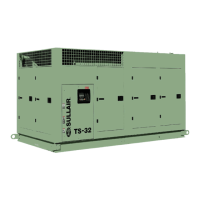SECTION 6 TS32 USER MANUAL
75
6.8 TROUBLESHOOTING—
INTRODUCTION
The information contained in the Troubleshooting
Guide has been compiled from field report data and
factory experience. It contains symptoms and usual
causes for the described problems. However, DO
NOT assume that these are the only problems that
may occur. All available data concerning a problem
should be systematically analyzed before
undertaking any repairs or component replacement
procedures.
In addition to the Troubleshooting Guide, consult the
Supervisor Controller manual for additional
troubleshooting guidelines pertaining to the
Supervisor Controller.
A detailed visual inspection is worth performing for
almost all problems and may avoid unnecessary
additional damage to the compressor. Always
remember to:
1. Check for loose wiring.
2. Check for damaged piping.
3. Check for parts damaged by heat or an elec-
trical short circuit, usually apparent by discol-
oration or a burnt odor.
Should your problem persist after making the
recommended check, consult your nearest Sullair
representative.
Table 6-2: Troubleshooting Guide
SYMPTOM PROBABLE CAUSE REMEDY
Compressor will not start Main disconnect switch open Close switch.
Line fuse blown Replace fuse.
Control Transformer Fuse Blown Replace fuse.
Motor Starter Overloads Tripped Reset. Should trouble persist, check whether
motor starter contacts are functioning properly.
Low Incoming Line Voltage Check voltage. Should voltage check low,
consult power company.
Replace Supervisor display module if no
display or erratic display.
Compressor Shuts Down With
Air Demand Present
Loss of control voltage Check incoming power.
Low incoming voltage Check control fuses and wiring.
Consult power company. The Sullair
Supervisor will provide indication of most
maintenance problems if control power has not
been lost. Shutdowns will occur upon a faulty
condition or a bad sender condition.
Excessive operating pressure Check maximum P2 pressure setting.
HIGH PRESS P1 display; Max P1 pressure
may be set too low. Consult factory for
recalibration.
Defective solenoid valve; solenoid valve
should cause inlet to unload when unload
pressure is exceeded. Repair if defective.
Defective blowdown valve; blowdown valve
should open when in the unload mode. Repair
if defective.
Open or shorted P1, P2, P3 or P4 sender
message; replace sender indicated.
Operating lever of inlet butterfly valve is loose
on valve shaft. Reposition the valve plate and
tighten lever set screw.

